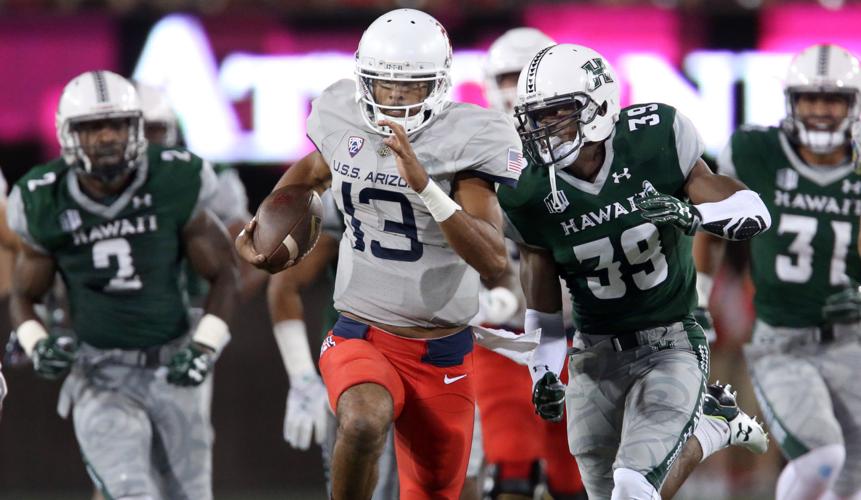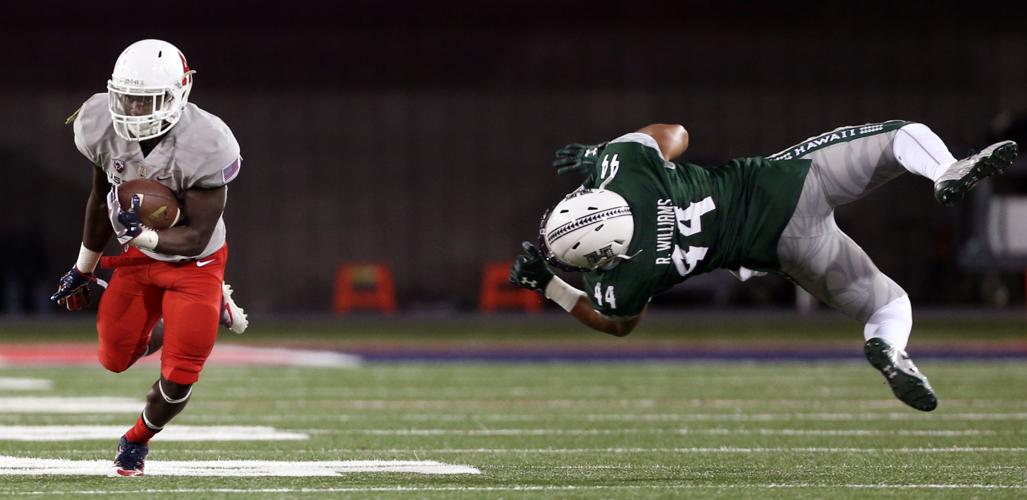This is the first in a three-part series looking back at the 2016 Arizona Wildcats football season and ahead to next year. Today’s installment: Offense.
The Arizona Wildcats’ offense simply did not look like itself for most of the 2016 season.
Even with a 56-point outburst in the finale, Arizona averaged fewer than 25 points per game. The Wildcats had averaged at least 33.5 in each of Rich Rodriguez’s first four seasons.
What went wrong? How can it be fixed?
With the ’16 season in the rearview mirror, we ask and answer three lingering questions about the Arizona offense.
1. Who will be Arizona’s starting quarterback in 2017?
If you thought this year’s quarterback situation featured too many twists and turns for the good of the team, next year’s could be even more labyrinthian.
As of this writing, the UA is projected to have five scholarship quarterbacks on its 2017 roster: veterans Brandon Dawkins, Anu Solomon and Khalil Tate, and freshmen Braxton Burmeister and Rhett Rodriguez.
That could change if Solomon elects to leave as a graduate transfer, in which case he could play for another FBS school next year without having to sit out a season. It’s a common practice for quarterbacks. The injury-plagued redshirt junior is in his fourth year academically.
With or without Solomon, the incumbent, Dawkins, has to be the favorite heading into the offseason. No one can dispute his running ability or competitiveness. But Dawkins remains a work in progress as a passer. The redshirt sophomore completed more than 50 percent of his passes in only two of Arizona’s final seven games.
Quarterbacks in modern-day offenses should complete at least 60 percent. Multiple Pac-12 QBs exceeded that threshold this season.
Tate experienced a similar drop-off in completion rate after a hot start. But bear in mind, the freshman never was supposed to play this season.
Tate was forced into action because of injuries to Solomon and Dawkins. Tate fared well in relief but struggled in his lone start vs. USC. All his other work came via mop-up duty.
The coaches are high on Tate’s upside. The question is whether he can improve enough in a year’s time to mount a serious challenge for the starting job.
Any incoming freshman has to be considered a long shot. Burmeister is supposed to enroll early after a record-setting high school career, so that improves his odds. Rodriguez already knows the UA offense, which his dad basically invented.
Because of injuries and other issues, Rich Rodriguez never declared a starting quarterback during the 2016 season. Next year will begin with just as much uncertainty.
2. Does Arizona have enough running backs?
On paper, yes. In reality … maybe.
As things currently stand — a necessary caveat in the fluid world of college football — the Wildcats should have four scholarship tailbacks on the 2017 roster: returnees Nick Wilson, J.J. Taylor and Zach Green, and newcomer Nathan Tilford.
This past season proved you can never have enough tailbacks.
The position was thought to be deep coming out of training camp with Wilson, Taylor and Orlando Bradford as the top three. But Wilson and Taylor got hurt, and Bradford got booted from the program. That left the coaches scrambling for a suitable complement to Green, who was fourth in the pecking order coming out of camp.
They eventually settled on Samajie Grant, who played extremely well at tailback after moving from wide receiver. But Grant’s eligibility has expired, so that fallback option no longer exists.
Ideally, Wilson and Taylor will stay healthy, giving Arizona two dynamic backs with breakaway capabilities. It’s a lot to ask in the case of Wilson, who has been hampered by injuries each of the past two seasons. Arizona can’t go into the 2017 season banking on him to play 12-plus games with a heavy workload.
Taylor flashed superstar ability in two games before suffering a broken ankle against Washington on a play that probably should have been whistled dead. The freshman had carried 37 times in about seven quarters at that point. At 5-foot-6 and 170 pounds, Taylor is best suited for 12-15 touches per game. Arizona has to have other options to avoid overworking him.
Green had a career game against Arizona State, rushing for 126 yards and two touchdowns. The coaches know they can count on the redshirt junior to be a reliable rotational piece.
Tilford is a four-star athlete who could bring a big-back element at 6-1 and about 200 pounds. How much he ends up playing next season could depend on the health of the veterans in front of him.
3. Was the season finale a sign of things to come for the UA offensive line?
It could be. Arizona obviously won’t rush for 500-plus yards every week, as it did in its 56-35 Territorial Cup trouncing of Arizona State. But the pieces are in place for the line to exceed its up-and-down 2016 performance.
Of the seven linemen who started games this season, only one, senior guard Freddie Tagaloa, is certain to leave. The other six have a combined 89 career starts.
Starting experience alone does not guarantee success. But no position group is more dependent on cohesiveness than the offensive line, so having almost everybody back is a boon.
Right guard Jacob Alsadek will be entering his fourth year as a starter, left tackle Layth Friekh his third. Redshirt freshman center Nathan Eldridge — pressed into a difficult situation after the death of projected starter Zach Hemmila in early August — gained invaluable experience as a first-time starter.
So did redshirt-junior right tackle Gerhard de Beer, whose first year as a full-time starter was cut short by a knee injury. De Beer’s absence created an opportunity for redshirt freshman Cody Creason, who started four games and appeared in a handful of others.
The favorite to replace Tagaloa — a supremely talented player plagued by injuries and inconsistency — is freshman Michael Eletise, who redshirted this season. Eletise and Tate were the highest-rated recruits in Arizona’s 2016 class. Eletise regularly dressed for games but did not play.
Whether it was Eldridge’s inexperience, injuries or other factors, it took until the final game for the line to reach its peak. Barring something unforeseen, the unit should be a force from the start next season. The onus then falls on the other positions — quarterback in particular — to restore the Arizona offense to its pre-2016 form.





